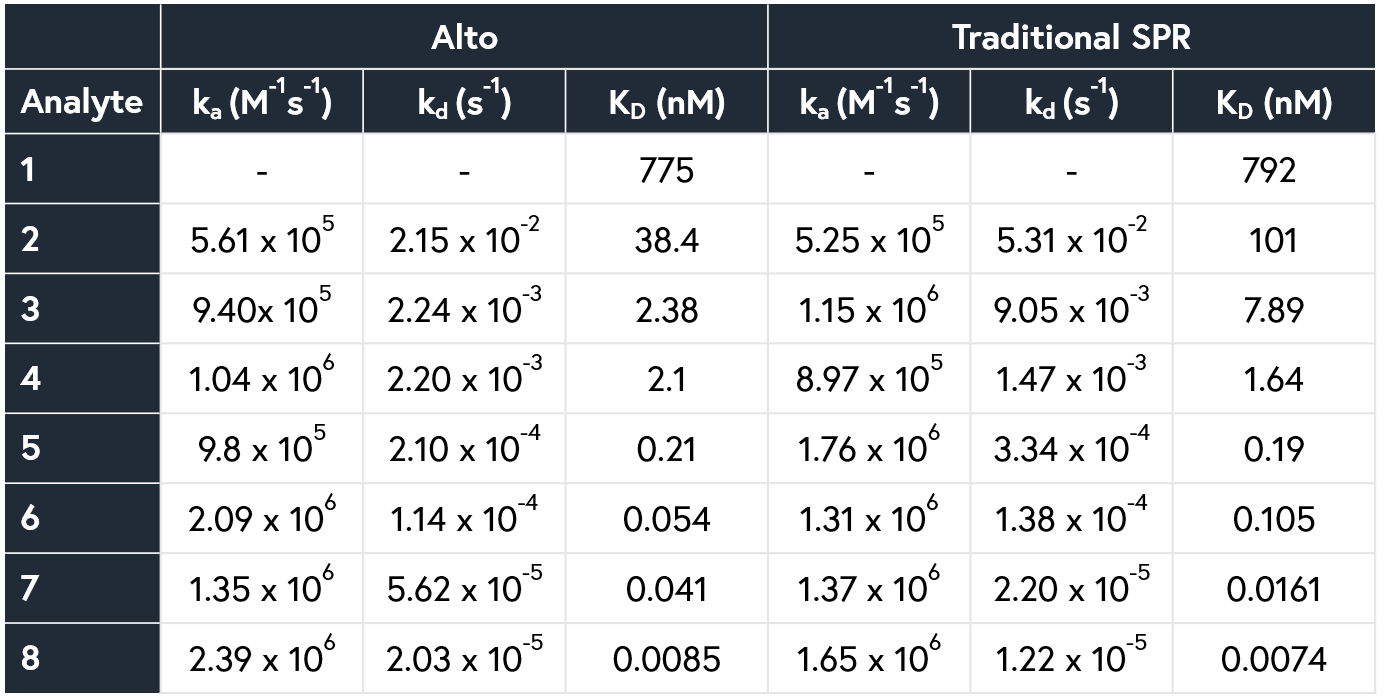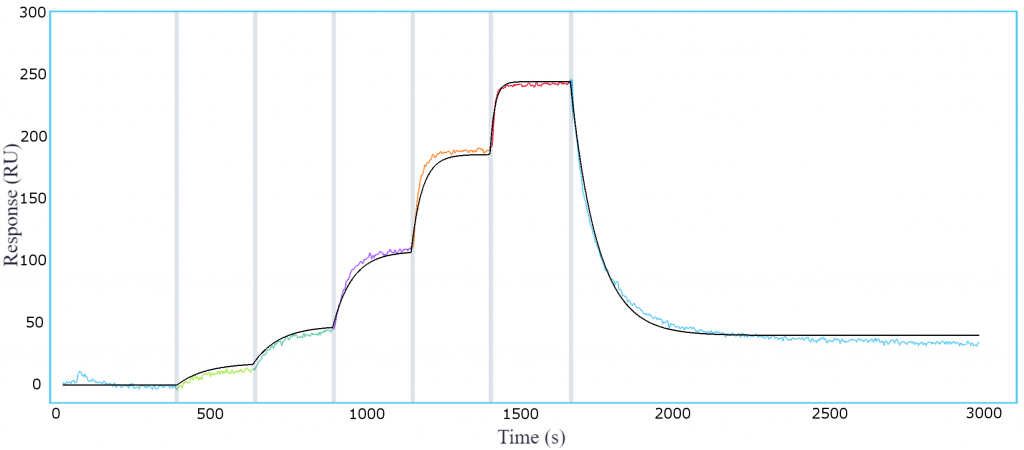Immunocore’s ImmTAC technology is a novel class of biologics that target cancer cells through T-cell redirecting immunotherapy.
Bispecific molecules, or bispecifics, are a growing subset of biotherapeutics that offer a promising new modality for the treatment of a wide range diseases. Due to their ability to bind to multiple targets and to offer diverse modes of action in clinical applications, bispecifics have been suggested to have superior therapeutic effects compared to other antibody-based therapies.
The complexity of bispecifics has rendered the need for broadly-applicable technologies that can accurately characterize these novel biotherapeutics. Surface plasmon resonance (SPR) is uniquely suitable for analysis and validation of bispecifics due to its ability to assess activity and quality across all stages of the drug discovery and development. In our latest application note, we use Alto digital SPR to accurately measure binding affinities spanning 5 orders of magnitude from 8 bispecific ImmTAC® molecules developed by Immunocore, and provide affinity and off-rate ranking that is equivalent to that obtained with traditional SPR.
Table of contents
- Immunocore ImmTAX® technology
- Kinetics and affinity analysis of bispecifics
- Accuracy of Alto compared to traditional SPR
- Optimizing bispecifics with Alto
Immunocore ImmTAX® technology
Immunocore is a leading T-cell receptor biotechnology company that is developing a robust pipeline of transformative biologics built on their proprietary T-cell receptor (TCR) technology. This novel class of biologics, called ImmTAX (Immune Mobilizing Monoclonal TCRs Against X disease), are bispecific molecules that combine an engineered TCR with a single chain antibody fragment (scFv) effector function.
While typical antibody-based therapies are restricted to targeting cell surface or secreted proteins, ImmTAX molecules integrate high-affinity TCRs that give them the ability to recognize intracellular cancer or viral antigens presented by human leukocyte antigen (HLA) with ultra-high affinity and selectively, and redirect the immune system to kill these cancer and/or infected cells via an anti-CD3 immune-activating effector function.

Immunocore is currently using their ImmTAX technology to target a wide range of indications, leveraging its potential to overcome the limitations of our natural immune system and current therapeutic approaches.
Kinetics and affinity analysis of bispecifics
We analyzed a subset of Immunocore’s ImmTAX technology, called ImmTAC (Immune Mobilizing Monoclonal TCRs Against Cancer), using Alto, our high-throughput SPR platform enabled with digital microfluidic (DMF) technology.
Characterizing both binding affinity and kinetics of potential therapeutic candidates in-vitro is critical to ensuring that these molecules will demonstrate the desired selectivity and specificity in vivo. In this application, kinetics and affinity were characterized for a panel of 8 different ImmTAC molecules targeted to peptide-HLA (pHLA). The experiment was completed in under 2 hours using a single cartridge, and required only 30 minutes of set up due to complete assay automation by Alto.
A single-cycle kinetics (SCK) format was used to eliminate the need for a regeneration step in between each concentration, and the resulting data was fit to a one-to-one binding kinetic model (with the exception of analyte 1, where the KD was calculated using affinity analysis). The resulting data, summarized in table 1, generated affinity values spanning 5 orders of magnitude, demonstrating the engineered biomolecules’ wide range of affinities and kinetics against the pHLA ligand.
Table 1: Kinetic parameters measured for 8 analytes using Alto.


Accuracy of Alto digital SPR compared to traditional SPR
The accuracy of Alto was verified by characterizing the same set of samples in a traditional fluidics-based SPR instrument. The % difference between the kinetics and affinity values obtained for all analytes on Alto and on the traditional SPR system are summarized in Table 2. The resulting values were well within the variation expected when comparing different instruments, operators and methods. Most importantly, the same rank order for all 8 bispecifics was obtained for both affinity and off-rate with both Alto and traditional SPR.
Table 2: % difference between data generated by Alto compared to traditional SPR across all analytes.
Characterizing bispecifics with Alto
Characterization of bispecific molecule binding is critical to defining their dual-target specificities and predicting their efficacy in their intended mechanism of action as therapeutics. In this study, binding analysis with SPR demonstrated the ImmTAC molecules’ varying affinities for the pHLA ligand while providing off-rate ranking, both critical measurements for selecting the best candidates to redirect T-cells for catalyzing tumor cell apoptosis.
With Alto’s ability to perform multistep assays and to discreetly control nano-liter sized droplets of each sample, the digital SPR platform simplifies analysis of bispecifics while showcasing extreme precision to provide insights into their quality and therapeutic performance. In addition, Alto’s 16 independent channels allow for simultaneous analysis of multiple bispecific proteins in many different assay formats, while significantly reducing hands-on time and sample consumption via complete assay automation.
Alto’s ability to provide high-quality binding data with a fraction of the time and sample volumes needed in traditional SPR systems demonstrates its unmatched capabilities in accelerating multi-analyte analysis and accelerating the bispecific protein discovery and development pipeline. To learn more about how you can use Alto to characterize your bispecifics, check out the full application note, or get in touch with our team for an in-person demonstration!

